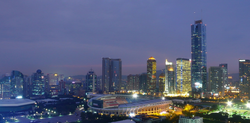Zengcheng 增城区 Tsengshing | |
|---|---|
 Gualü Square in Licheng Subdistrict | |
 | |
 Zengcheng in Guangzhou | |
| Coordinates: 23°17′17″N113°49′41″E / 23.28806°N 113.82806°E | |
| Country | People's Republic of China |
| Province | Guangdong |
| Sub-provincial city | Guangzhou |
| Area | |
• Total | 1,741.4 km2 (672.4 sq mi) |
| Population (2020 census [1] ) | |
• Total | 1,466,331 |
| • Density | 842.04/km2 (2,180.9/sq mi) |
| Time zone | UTC+8 (China Standard) |
| Postal code | 511300 |
| Area code | 020 |
| Website | http://www.zengcheng.gov.cn/ |
| Zengcheng | |||||||||||||||
|---|---|---|---|---|---|---|---|---|---|---|---|---|---|---|---|
| Chinese | 增城 | ||||||||||||||
| Guangdong Romanization | Zeng1-xing4 | ||||||||||||||
| Hanyu Pinyin | Zēngchéng | ||||||||||||||
| Postal | Tsengshing | ||||||||||||||
| Literal meaning | Expanding City | ||||||||||||||
| |||||||||||||||
Zengcheng District (alternately romanized as Tsengshing) [a] is one of 11 urban districts of the prefecture-level city of Guangzhou,the capital of Guangdong Province,China.



